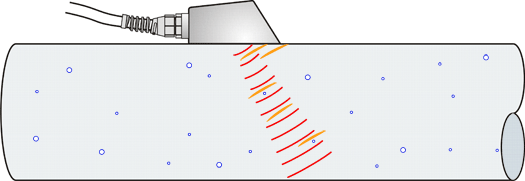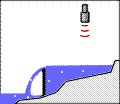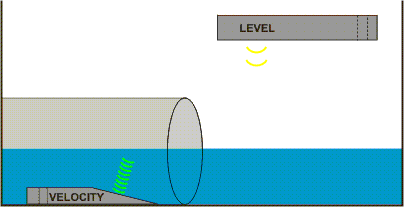
|
|
|
|
| Greyline Product List | |
| What's New from Greyline | |
| More Information |
|
Ultrasonic
Level
Greyline ultrasonic sensors are mounted at the top of a tank or in a position above the liquid being measured. The sensor continuously transmits pulses of high frequency sound (typically 42 kHz) which travel away from the sensor, hit the surface of the liquid and return to the sensor. |
 |
| The
instrument electronics measure the time it takes from
transmitted sound to return of the echo. With reference
to the speed of sound in air, the exact distance of the
liquid surface from the sensor can be calculated with
high accuracy (±0.25% of maximum range). Since the speed of sound is affected by air temperature, Greyline ultrasonic level sensors include a built-in temperature sensor. Level/distance measurements are automatically temperature compensated throughout the operating temperature range of the sensor. The sensor should be positioned so that it has an clear "view" of the liquid surface and away from ladders, pipes or other obstructions. Greyline recommends 1 ft. from the sidewall for every 10 ft. depth (300 mm for every 3 m depth). False echoes from agitators (sweeping under the sensor), turbulence and waves can be filtered and disregarded by the instrument. Greyline models range from simple 4-20mA level indicating transmitters, to sophisticated monitoring, controlling and logging models. Return to Greyline Products for Level model details and specifications. |
|
|
Doppler
Flow Doppler flow meters measure flow from outside a pipe with a clamp-on sensor. Greyline Doppler meters continuously transmit high frequency sound (640 kHz) that travels through the pipe wall and into the flowing liquid. Sound is reflected back to the sensor from solids or bubbles in the fluid. If the fluid is in motion, the echoes return at an altered frequency proportionate to flow velocity. Doppler flow meters continuously measure this frequency shift to calculate flow. |
 Measure Flow of Dirty or aerated Liquids from Outside a Pipe |
|
The Doppler effect was first documented in 1842
by Christian Doppler, an Austrian physicist. We hear everyday examples of Doppler: the sound
of a train whistle changing pitch as it passes by, or the
exhaust noise from a race car as it speeds past our
location. The Doppler technique only works on liquids which contain solids or gas bubbles to reflect its signal. These are "difficult" liquids that may damage regular flow meters: slurries, sludge, wastewater, abrasives, viscous and corrosive chemicals. Because the sensor mounts on the outside of the pipe, there is no pressure drop and no obstruction to flow. For best performance Doppler sensors should be mounted away from turbulence creating devices like pipe elbows and tees, and away from velocity increasing devices like controlling valves and pumps. Typical accuracy is ±2% of full scale. Doppler instruments include a clamp-on ultrasonic sensor, connecting cable and an electronics enclosure which can be mounted at a convenient location nearby (within 500 ft / 152 m). Sensors can be rated intrinsically safe for mounting in hazardous-rated locations. Return to Greyline Products for Doppler model details and specifications. |
|
Open Channel Flow The common method of measuring flow through an open channel is to measure the height or HEAD of the liquid as it passes over an obstruction (a flume or weir) in the channel. Using ultrasonic level technology, Greyline open channel flow meters include a non-contacting sensor mounted above the flume or weir. By measuring the time from transmission of an ultrasonic pulse to receipt of an echo, the water level or "Head" is accurately measured. |
 |
| Flumes and
weirs are specially designed channel shapes that
characterize the flow of water. Common types are
Rectangular Weirs, V-Notch Weirs, Parshall flumes and
Palmer Bowlus flumes. The choice of flume or weir type
depends on the application: flow rate, channel shape and
solids content of the water. Contact Greyline Instruments
(info@greyline.com) for
advice on selection of a suitable flume or weir for your
application. Greyline open channel flow meters can be calibrated to any flume or weir by menu selection. The open channel flow meter electronics use an internal formula to calculate flow rate (Flow = K Hn, where 'K' and 'n' are constants and 'H' is Head as measured by the instrument). Calibration to uncommon or custom flumes can be done by direct entry of 'K' and 'n' constants. Greyline also offers a PC software program "Find K&n" to develop calibration constants from a flume or weir flow chart. Greyline open channel flow meters include a non-contacting ultrasonic sensor, connecting cable and an electronics enclosure which can be mounted at a convenient location nearby (within 500 ft / 152 m). Sensors can be rated intrinsically safe for mounting in hazardous-rated locations. The instruments display, totalize, transmit and control, and some models include data logging/flow reporting systems. Return to Greyline Products for Open Channel Flow model details and specifications. |
|
| Area-Velocity Flow | |
| Measure open
channel flow without a flume or weir. An Area-Velocity Flow Meter continuously measures both Level and Velocity to calculate flow volume in an open channel or pipe. The ultrasonic sensor is installed at the bottom of a pipe or channel. To measure water level the sensor transmits ultrasonic pulses that travel through the water and reflect off the liquid surface. The instrument precisely measures the time it takes for echoes to return to the sensor. Based on the speed of sound in water, the level is measured with accuracy of ±0.25%. Flow velocity is measured with an ultrasonic Doppler signal continuously injected into the water. This high frequency sound (640 KHz) is reflected back to the sensor from particles or bubbles suspended in the liquid. If the fluid is in motion, the echoes return at an altered frequency proportionate to flow velocity. With this technique the instrument measures flow velocity with accuracy of ±2%. Greyline Area-Velocity Flow Meters work in partially full and surcharged pipes, rectangular, trapezoid and egg-shaped channels. |
|
| A separate down-looking ultrasonic sensor can be used for highly aerated or turbulent flow applications. It measures level by transmitting ultrasonic pulses through the air to the liquid surface with accuracy of ±0.25%. Along with the level sensor, a submerged Doppler velocity sensor is used to measure the water velocity. |

|
| Return to Greyline Products for Area-Velocity Flow Meter model details and specifications. | |
For
complete product literature and applications information
on Ultrasonic Level, Open Channel Flow and Doppler Flow
please contact Greyline Instruments. (To receive complete
information please provide your
name, mailing address, phone and fax numbers):
|
Copyright © 1998-2010 [Greyline Instruments Inc.] All rights
reserved.
Information in this document is subject to change without
notice.
